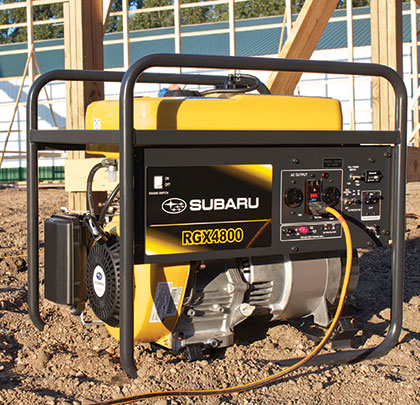As with any piece of equipment that provides power to other tools, the only time one seems to notice a generator is when it’s not working. Generators get thrown around, beaten, and abused, yet they’re always expected to work with one pull. Even though they’re built for abuse, generators won’t last without some regular maintenance. Here are 10 basic tips to keep your generator energized for each job:
1. DON’T BE FOILED BY OIL
Check the oil before each use. If it’s a new generator, change the oil after the first 20 hours of use to remove assembly lube and metallic particles created during the break-in period. Otherwise, change the oil every 100 hours or sooner if operating in dirty conditions.
2. DON’T RIDE DIRTY
Dirty fuel is a result of improper storage or refilling tanks in dusty conditions. To prevent this problem, store fuel in an OSHA-approved receptacle and keep out of high-traffic areas. Also, don’t refill in windy conditions where dust is more prevalent.
3. CLEAR THE AIR
Check the condition of the air filter daily and clean when necessary. Regardless of how dirty it is, clean the filter every 100 hours and change it monthly.
4. KEEP IT CLEAN
Cleaning the engine removes potentially harmful dirt and gives the operator a chance to spot service concerns. Never use a pressure washer as it could cause more harm than good. Instead, use an air supply to blow off any dust and a clean rag with degreaser to wipe off excess dirt and grease.
5. ON THE LOOKOUT FOR LEAKS
Once the equipment is clean and dry, check for any or oil leakage. If a leak is spotted, tighten the parts causing the leak or replace them immediately.
6. HANG TIGHT
Cleaning the engine will also help reveal any obvious damage and loose parts. Take time to tighten loose parts that could vibrate and potentially harm nearby components.
7. DON’T LOSE THAT SPARK
Inspect the spark plugs every 100 hours for damage, oil residue, and excessive carbon buildup. If residue or carbon buildup is found, clean with a wire brush or spark plug cleaner. Immediately replace any plugs that have cracked porcelain.
8. AVOID STRAINER STRAIN
Clean and inspect the fuel strainer located in the fill port of the fuel tank every month. If there is sediment in the fuel strainer, clean and return, or replace if torn.
9. ANNUAL INSPECTION
On an annual basis, take the time to conduct a general inspection of the generator looking for any dirty, broken, or misaligned parts. Furthermore, check the fuel hose each year and replace if there are cracks present.
10. STORE IT PROPERLY
If the generator won’t be used for more than 30 days and the user does not plan to use it for an extended period of time, take special steps to protect the engine. First, conduct all suggested daily maintenance items. Then, remove the battery, clean the posts, and ensure it’s fully charged. Next, drain the fuel from the fuel tank and carburetor float chamber. To prevent corrosion in the cylinder bore, remove the spark plug and inject a few drops of oil through the plug hole. Gently pull the recoil starter knob two or three times before the spark plug is placed back in the plug hole. Additionally, pull the recoil starter knob until resistance is felt and leave in that position. End the process with a final cleaning, ensuring that all cooling air slots and openings are unobstructed. Place a protective cover around the generator and store it in a dry place.
Exercise the generator every 2 months if gas or oil is present in the engine. If the generator will be stored for longer periods, drain the oil and gas from the carburetor, put oil in the cylinder and pull until resistance is felt. ■
About The Author:
Dale Gabrielse is in sales and marketing at Subaru Industrial Power Products. For more information about generators, visit www.subarupower.com.
Modern Contractor Solutions, February 2015
Did you enjoy this article?
Subscribe to the FREE Digital Edition of Modern Contractor Solutions magazine.



